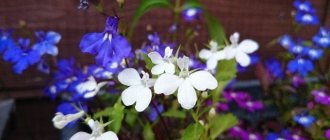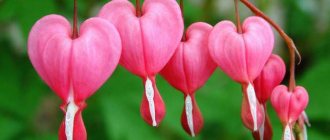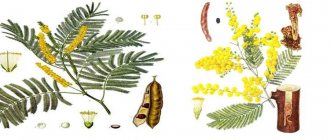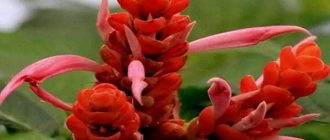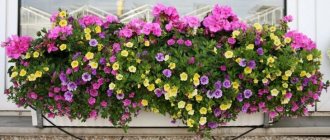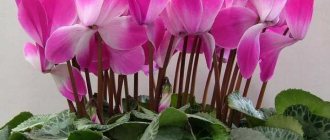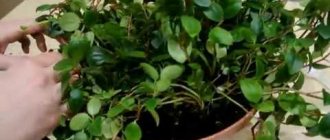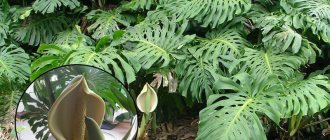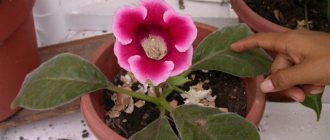Description
The dicentra flower has the following characteristics:
- the bush grows on average 50 centimeters, the height of some of its species reaches one meter;
- the root mass is long, fleshy, goes deep underground;
- the leaves are pinnate and ash-green;
- petioles are present on the surface of each leaf blade;
- the shape of the inflorescences is heart-shaped;
- the color of the inflorescences is light red or pale pink;
- flower circumference - up to two centimeters;
- racemose inflorescences;
- at the end of flowering, a seed capsule is formed, which contains oblong black grains; their germination persists for two years.
Dicentra varieties
Dicentra magnificent is a perennial that reaches one meter in height. Large leaves have a pinnately dissected shape. The leaf is green on the top and dark gray on the bottom, located on a ten-centimeter petiole. The inflorescences consist of heart-shaped flowers, the diameter of which is three cm. The raceme inflorescences reach twenty cm in length. The peak of dicentra flowering occurs in late spring and early summer. After flowering, the plant goes into a dormant state that lasts until the end of winter.
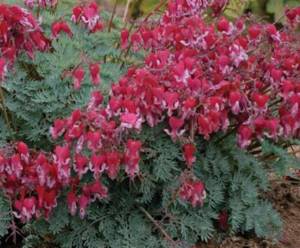
Dicentra
GoldHut variety was developed more than 10 years ago. It has pink flowers and leaves with a golden hue.
Dicentra beautiful (Taiwanese) is a miniature light green plant, reaching forty cm. The formation of buds begins in June. Taiwan dicentra blooms until autumn. Inflorescences are represented by both already blooming flowers and closed buds. The flowers are snow-white or beige in color.
Dicentra exceptionala does not grow more than 30 cm. The leaves with a bluish tint resemble a fern in appearance. The color of the flowers ranges from white to dark purple. The peak flowering period of Dicentra exceptionala lasts for two months. This variety is not characterized by abundant flowering. Flower growers use it for winter forcing.
Dicentra climbing in the wild grows in the Himalayas. The plant becomes covered with white-pink or yellow flowers in July. The flower vine reaches two meters in length. In our latitudes, the variety is grown as an annual crop.
Dicentra nobulosa - a small flower slightly more than 10 cm high with a tuberous root. The variety blooms with snow-white flowers. The leaves secrete a poisonous juice that is used for medicinal purposes.
Dicentra vagrant is a relict thousand-year-old plant. The variety has miniature sizes and will not grow more than fifteen cm. Large flowers can be snow-white or purple. Dicentra vagrant has dark gray leaves. In landscape design, the plant is used to decorate rock gardens.
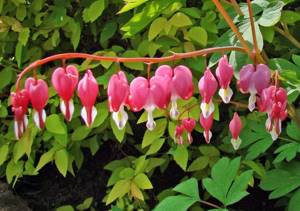
Dicentra branch with flowers
Requirements for landing conditions
The dicentra flower should be planted in a permanent area in the spring, when temperatures are consistently warm. You can also plant dicentra in open ground with the onset of autumn.
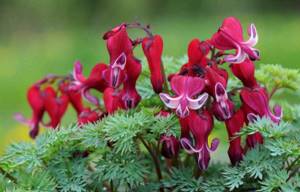
This plant must be planted in an area well lit by sunlight; partial shade is also welcome. But in sunny areas, flowering will begin much earlier and last longer.

The optimal soil for dicentra is a light, drained, mineral-rich substrate. It is recommended to prepare the soil in advance.
When planting in spring, the soil is prepared in the fall - it is dug up and fertilizers are added. And in the spring they plant dicentra.

How to grow liatris in open ground
Soil preparation
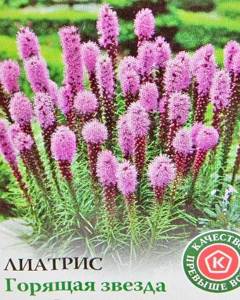
Liatris can also be grown through seedlings. To do this, in early spring we plant seeds in boxes or containers with fertile substrate. Scatter the seeds over the surface of the substrate and lightly sprinkle with clean river sand. We transplant the seedlings as they grow into separate containers (cups, pots). Liatris grown from seedlings is planted in a permanent place only after a year.
Dividing rhizomes
The simplest and most preferable way to plant this flower is to plant parts of the rhizome of an adult plant. At the same time, there is no need to worry about the condition of the mother plant, since liatris tolerates division of rhizomes well. The root system of this plant is distinguished by the presence of special nodules that are connected to each other by shoots. These nodules look like a flattened onion. Plants obtained by dividing rhizomes bloom in the first year.
Plants older than 3 years are suitable for propagation. In the fall, we carefully dig up the roots of the flowers after their green mass dies. We clean all the nodules from any remaining soil, dry them and sort them. To obtain specimens of liatris with early flowering, we use tubers whose diameter is 2 centimeters or more. We grow smaller nodules in pots or boxes in greenhouses or at home. We plant small tubers to a depth of 6-8 cm.
Liatris care
Feeding with fertilizers
Caring for this flower also includes regular feeding, which guarantees lush and long-lasting flowering. In the spring we feed it with nitrogen fertilizers, which have a beneficial effect on the growth of the green mass of liatris, and in the summer with phosphorus-potassium fertilizers. In the fall, we again use nitrogen fertilizers, which increase the resistance of the plant’s rhizomes to wintering. A lack of nitrogen in the plant is indicated by yellowing of its leaves and peduncles.
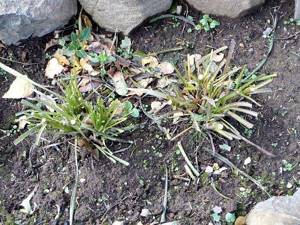
Since liatris is frost-resistant, in our area, unlike grapes, it does not require serious shelter for the winter. In regions with harsh winters, it will be enough to pour a 10-15 cm layer of compost on the place where the flowers grow. Fallen leaves or peat are also suitable for insulating liatris.
All about planting and caring for liatris in open ground
https://fikus.guru/sadovye-cvety-rasteniya-i-kustarniki/liatris-posadka-i-uhod-v-otkrytom-grunte.html
https://sotkiradosti.ru/tsvety-na-dache/tsvety-liatris-posadka-i-uhod
Disembarkation algorithm
The algorithm for planting dicentra in open ground is as follows:
- planting holes are being prepared;
- there should be an interval of at least half a meter between bushes;
- drainage is placed at the bottom of each hole; crushed stone or expanded clay can be used;
- garden soil with rotted compost is poured onto the drainage layer;
- the seedling is lowered and covered with soil on top.
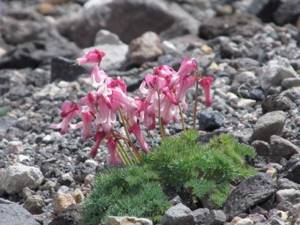
To make the soil substrate lighter, it is recommended to mix it with some sand and lime.
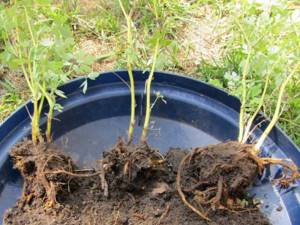
Rules for planting plants in the garden
Dicentra is an ideal plant for planting in partial shade. Practice shows that in open sunny places the height of the bushes is much smaller, the foliage is not so decorative, and the color of the corollas is more modest. The soil should be light, without stagnant water. Clay soils will need to be improved with sand and peat. Add drainage material to the bottom of the planting hole.
It is better to place 2-3 plants in each hole to form a lush bush. The root system is buried in soil fertilized with compost and a handful of wood ash. After planting, the plant is watered and protected from light for several days. A mature “broken heart” bush needs a lot of space. When planting plants, you need to leave a space of at least 50 cm between them.
Watering
It is necessary to moisten the soil as the top layer dries. After each irrigation of the soil, a loosening procedure is carried out to ensure the drainage of excess moisture and aeration of the roots. Be sure to remove weeds around the bush.
For irrigation, only warm, settled water is used. It is unacceptable to water the dicentra with tap water from a hose; this will cause significant harm to it. The water must be settled, but it is better to stock up on melt or rain water for watering the plants. Make sure that moisture does not stagnate in the root mass, otherwise this can lead to the development of root rot and other diseases that are no less dangerous for the plant.
Methods of transplantation and propagation of dicentra
Dicentra reproduces in three traditional ways:
- Rhizome division;
- Ground sprouts;
- Seeds.
Since the plant produces few seeds, and in some varieties, in particular the “Velikolepnaya” variety, they do not exist at all, propagation by seeds is not advisable. In addition, growing seeds is also difficult, so the most optimal method of propagation is considered to be planting parts of rhizomes or shoots.
The optimal time for dividing plants is the end of summer - at this time above-ground shoots begin to die off. You should carefully dig up the roots, remove them from the soil and dry them, because their slightly sluggish state promotes elasticity and reduces the fragility of the roots.
After this, it is necessary to divide the rhizomes so that each part contains 3-4 buds capable of forming shoots. After this, each piece of root should be buried in the soil in dimly lit areas and watered generously with warm water. To protect the roots from pests, they are sprinkled with ash. When the root pieces take root, they are transplanted into flower beds and flower beds.
If an old bush of a plant is used for propagation, it is completely dug up, and then the rhizome is carefully disassembled into elements, dead pieces and thin shoots are removed.
Dicentra can be replanted in early spring. In this case, choose the time when the shoots either have not woken up or have just begun to grow. It is recommended to divide no more often and at least once every 5-6 years, since at this age the aging and death of plant roots begins.
Dicentra is planted in the following order:
- Dig shallow holes in the flowerbed. The distance between them depends on the size of the adult plant, and should be approximately 30-40 cm.
- Each hole is designed for 3-4 divisions - this way the dicenter will be more magnificent.
- The holes are filled with soil, which is slightly compacted.
- Warm water, heated by the sun, is poured over the top.
Propagation using ground cuttings is carried out in the spring. It is necessary to carefully rake the soil at the base of the bush, and then use a well-sharpened knife to cut off small parts of the plant that have the so-called “heel”. It is recommended to keep the cut cuttings in the stimulator for about a day so that roots appear faster, and then plant them in abundantly watered soil.
The top of the planted cuttings should be tightly covered with plastic wrap. The appearance of roots occurs after a month, but only next year the sprouts can be planted in their designated place in the flower bed.
In order for the beauty and originality of the dicentra to be noticed, plant it in flower pots, cache-pots or large ceramic flowerpots.
Fertilizer application
All dicentra varieties require fertilizing. With the onset of spring, diluted nitrogen fertilizer is applied under the roots. When the budding period begins, it is recommended to add superphosphate to the root.
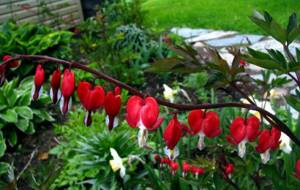
With the onset of autumn, the dicentra is fed with diluted rotted mullein. For the winter, the bush is mulched with humus or compost. To ensure a longer flowering period, it is recommended to remove faded inflorescences so that new buds will form in their place.
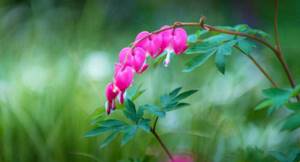
Preparing clematis for winter
new-dubki.ru
After the first frost, it is worth considering covering clematis for the winter. What plants fear most is not frost itself, but icing, high humidity and cold wind. Therefore, the shelter must allow air to pass through and at the same time protect from the factors described above. You should not cover it too early to prevent the clematis from drying out and rotting. The best time is October, when the temperature drops steadily to -3°C.
Before covering clematis for the winter, carry out the following procedures:
- in August-September, feed the plants with phosphorus-potassium fertilizers (0.5 tablespoons of superphosphate and potassium sulfate per bucket of water);
- remove old leaves from clematis of the first and second pruning groups;
- treat the bushes with 3% Bordeaux mixture or Fundazol (20 g per 10 liters of water) to prevent the appearance of fungal diseases;
- put poisoned baits for rodents, who in a hungry winter are not averse to feasting on clematis shoots;
- Cover each bush with peat, humus or compost (1-2 buckets) so that water does not accumulate at its base in the spring.
jubkiplus.ru
Clematis of the first and second groups of pruning for the winter can be rolled into a ring and sprinkled with dry leaves or spruce branches. You need to roll it in several stages, gradually, so that the stems do not crack. Then secure the vine to the ground with metal staples. Place a wooden box on top, cover it with plastic film, roofing felt or other waterproof material, cover it with bricks and sprinkle it with a 25-centimeter layer of earth. You can also use wooden boards instead of a box.
Remove the cover in the spring only after the danger of return frosts has passed. Do this gradually so that the plant does not die out. First, make a few holes, gradually remove the top layers, and after the weather warms up, remove all the cover.
How to cover clematis for the winter - all about preparation, pruning and proper shelter. These fragile vines do not like either frost or autumn overheating. Learn how to prepare your clematis for winter without letting it freeze or dry out.
We took a step-by-step look at how to plant and replant clematis. You also learned how to prune clematis by group and how to properly cover the vine for the winter. All that remains is to put the acquired knowledge into practice so that next year your plants will surprise everyone with their beauty!
Articles that may also be of interest to you:
Features of transplantation
Every five years, it is recommended to replant the dicentra, changing the soil substrate. The transplantation procedure is performed in the spring. During replanting, garden soil mixed with wood ash, peat and sand is used. All movements during the transplantation process must be careful to prevent injury to the roots.
During the transplanting process, you can also divide the root mass into several parts, after which each resulting seedling can be planted in a new area. After planting, be sure to apply superphosphate or nitrogen-containing fertilizer.
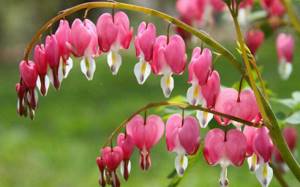
Varieties
There are more than 20 varieties of dicentra. Of these, about 10 are cultivated plants. The names of the varieties fully describe the beauty and grandeur of these flowers.
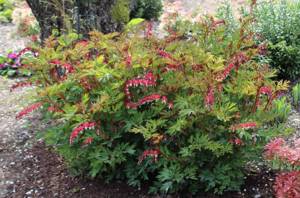
For example, dicentra Stuart Butman, the planting and appropriate care of which do not differ from other varieties of plants planted in open ground, is a chic bush of elite origin. You can see this from the photo.
Dicentra is magnificent
This is a perennial plant that grows up to 20 cm in height and has fleshy shoots. The leaves are dicentra - palmately shaped and form a lush basal rosette. The inflorescence in the form of a one-sided brush is curved in an arc, the length of which can reach 15 cm.
Small pink flowers hang along its lower edge. Their diameter does not exceed 2.5 cm. Magnificent Dicentra blooms at the end of May and decorates the garden with its lush blooms for three months. Despite the fact that the plant is frost-resistant, it is recommended to sprinkle it with mulch in the fall.
This species can have not only pink flowers, but also white ones, and therefore it is also called Dicentra White; planting and care in open ground are the same as for the magnificent representative of the variety. Below are photos that show flowering bushes.

When to plant tulips in open ground in the fall in 2021 The tulip is a common flowerbed flower that looks spectacular in the friendly company of other flowering plants...
Dicentra is beautiful
This plant variety was introduced to Europe from British Columbia. With timely planting in open ground and proper care, beautiful dicentra bushes can reach 30 cm in height (photo plants will help distinguish the variety from the rest). The leaves are palmately shaped, bright green on the front side and bluish on the back surface.
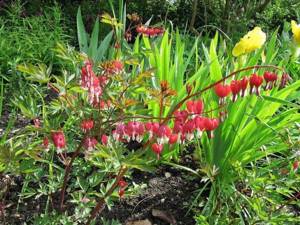
The arched inflorescences of the plant, planted in open ground, are in the form of a brush and reach 15 cm in length. All of them are strewn with small pink or white flowers, the diameter of which does not exceed 2 cm.
If you follow all the recommendations for planting and care, then the beautiful dicentra will bloom all summer, starting from the end of May and ending in the beginning of autumn. The variety is considered frost-resistant, but experienced gardeners still recommend covering it for the winter. How to do this is shown in the photo below.
Dicentra capulata
The homeland of the hooded variety is the eastern part of North America (Washington and Oregon states). The root system of the plant contains small tubers. The leaves are dissected into thin slices of a gray-green hue. Forming a rosette, they create the appearance of a lush pillow.
The shoots of the plant reach 30 cm in height and are strewn with many small white flowers with long spurs. Flower growers very often grow this variety indoors.
Interesting! There are varieties of dicentra capulata with pink flowers, and not so long ago another species appeared with lemon-yellow petals.

Is it possible to plant several orchids in one pot: useful information Some people plant two or more orchids in one pot to ensure the beauty and density of flowering. Such…
Dicentra Goldenvine or golden-flowered
The birthplace of the flower is considered to be Mexico, as well as the slopes of California. Plants of this variety can reach a height of 45 to 150 cm. Dicentra Golden Vine blooms in late spring. Flowering lasts until autumn. The oddly shaped petals have a deep yellow tint, hence its name.
In the natural environment, this dicentra is most often found in areas damaged by fire, and it grows in open ground at lightning speed. Therefore, it does not require special skills in planting and care. The photo shows a beautiful golden representative of the flora.
Growing from seeds
The seed method of growing dicentra is not used, since this procedure is quite labor-intensive and expensive. This method is used only in nurseries. But some experienced gardeners still try to grow dicentra from seeds. To propagate by seed you need:
- sow the collected seed material in the first or second decade of September;
- transfer the container with the sown seeds to a cool room, it can be a balcony, veranda, the air temperature should not exceed 18 degrees Celsius;
- In about a month, young shoots will appear;
- when two true leaves are formed on them, a picking procedure is carried out; it is recommended to plant each seedling in separate containers; peat cups are best suited for this.
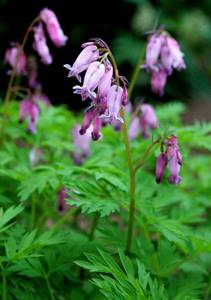
Seedlings grown in this way will begin to flower only after a few years.
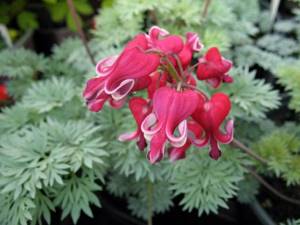
Characteristics and care of the dicentra
The shrub is found among the wild flora of the North American continent and Asia, and was brought to Europe in the mid-18th century. For the first time, a scientist from Sweden, Carl Linnaeus, took up its description, study and classification.
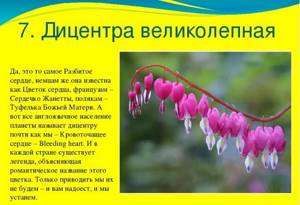
- Externally the dicentra will not leave its contemplators indifferent, attracting with the graceful contours of the branches and tassel-like inflorescences of snow-white, pinkish, purple or yellow tones in the shape of a heart, with white petals-drops in the middle.
- Residents of each state gave the flower its own special name: “broken heart” - the Russians called it, “Jeannette’s heart” - the French, “Mother of God’s slipper” - the Poles, “lady’s medallion” - the British. Scientists, people far from lyricism, call it “double-spurred” because of the shape of the petals in the middle of the flower, very reminiscent of the spurs of a cavalryman.
- This perennial shrub is one of the most unpretentious in terms of planting and care. Residents of the central zone of the Russian Federation can simply plant it in the soil and enjoy the growth and flowering of the dicentra. However, to create ideal conditions for your green “friend,” do not neglect the advice of experienced gardeners.
Beauty
Here's what they are:
- The most favorable place for shrubs is shady, under the crowns of large trees. The bright sun will provide it with rapid but short-lived flowering, as well as weak development of greenery.
- Harmonious growth of the plant will be ensured by planting in loose, humus-enriched soil with weak acidity. You should not expect that dicentra will survive in heavy soil, rich in alumina, capable of retaining moisture - for it this is fraught with diseases, which will ultimately lead to the death of the plant.
- The same applies to planting in areas where groundwater lies close to the soil surface. If you are not able to drain the soil before planting the dicentra, choose a habitat for it slightly above the level of the site.
- By feeding the perennial properly, you will ensure its excellent growth without burdening yourself with frequent replanting of the dicentra (about once every five to six years).

dicentra shoots should be cut at a level of 3-5 cm from the ground and sprinkled with wood ash. As a rule, a perennial does not need protection, however, if severe frosts strike, it is better to protect its root system with a dense layer of peat. As soon as the temperature drops, it can be removed so that the roots do not rot.
After winter, it is necessary to sprinkle the roots of the bush, which secrete poison, with soil. Wintering at home is also suitable for perennials. To do this, keep the pot with the plant in a cool room until the first days of January, watering it from time to time. Afterwards, force the bush by moving it to a warm room, closer to the light and starting feeding.
Cutting procedure
With the onset of spring, dicentra cuttings can be carried out. To do this, a young pagon is cut off; its length should not be less than 10 centimeters. This shoot is immersed in a container with a root-forming agent for 24 hours. Then they are transplanted into flowerpots. The top is generously moisturized. Cover with a jar or cut bottle. This jar will need to be removed no earlier than three weeks later.
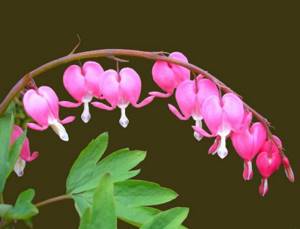
When the cutting takes root, it can be planted together with a ball of earth in a permanent place of growth.
Reproduction methods
The plant propagates by cuttings, dividing old mother bushes and rarely by seeds.
Planting with seeds
In the conditions of the middle zone, seeds most often do not set. This is probably due to the lack of a pollinator. Therefore, the plant is propagated vegetatively when the flowers are in a dormant period. But if you still buy seeds, then you need to know that dicentra needs to be sown taking into account time, so that it can have time to germinate, sprout and take root after transplantation.
Bush shoots appear on days 25-30 at a temperature of about 20 degrees. The seedlings are planted and covered with leaves for the winter. Therefore, sowing should be done at the end of July. Autumn seedlings do not need to be picked. Seedlings begin to flower only in the third year. You can also sow seeds for seedlings in early spring.
Reproduction by division
The bushes are divided and replanted in mid-spring or early autumn. Why is the plant dug up and carefully cleared of soil?
The root system is quite fragile and needs careful handling. In order to prevent breakage before dividing, the roots can be slightly withered
One division should contain 2-3 shoots with roots. To get a bush with several peduncles in the first year, you need to place 3-4 divisions in one hole.
Reproduction by cuttings
Cuttings from the “magnificent” dicentra are taken at the end of winter, and from the “beautiful dicentra” - throughout the summer season. To do this, carefully scrape away the soil from the shoots and cut off the cuttings with a sharp knife, which are then planted in a greenhouse in a light substrate 8-12 cm deep and shaded. After a month, sprouts form. All this time, the earth is kept moist and the greenhouse is ventilated. Rooted cuttings are transplanted to a permanent place in the spring of next year.
Cuttings can be used both stem and root. Why use pieces of roots measuring 15-25 cm.
What diseases do they face?
In the photo of dicentra flowers you can see that the plant blooms profusely and for a long time. At the same time, it is quite resistant to the development of all kinds of diseases. In some cases, flower growers are faced with diseases such as:
- tobacco mosaic;
- ring spot.
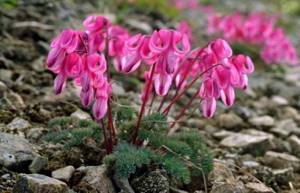
To get rid of such diseases, it is recommended to treat the soil with any fungicidal preparation.
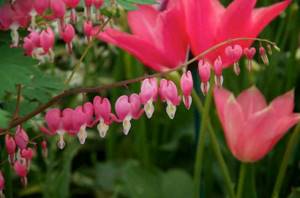
And the above-ground parts of the plant should be carefully examined for the presence of disease. All damaged ground areas are carefully cut off, and the cut areas are treated with wood ash.
Pests and diseases
Dicentra gets sick quite rarely, thanks to her high immunity. But the possibility of pests and diseases cannot be completely ruled out. Tobacco mosaic and ring spot are the most common infections for dicentra. These diseases are easy to identify by the appearance of the plant: young leaves become covered with spots and stripes, and older leaves become similar to oak leaves, known for their pattern in the form of rings elongated along the contour.
There is also a possibility of contracting microplasma disease. In this case, dicentra flowers acquire an unnatural yellow and green color, and the growth and development of the plant stops.
To prevent these diseases you will need:
- treat the soil with a formaldehyde solution (5%) a month before planting plants in it.
- Regularly treat planted bushes against aphids, which are carriers of various diseases.
- destroy weeds near the bush in a timely manner.
What pests do you encounter?
Most often, the dicentra is attacked by a pest such as aphids. It can be seen by the inclusions and cobwebs that appear on the surface of the leaves. The surface of the leaves becomes sticky and wet. It is imperative to get rid of such a pest, since the plant may die.
For this purpose, acaricidal drugs are used. To destroy aphids, you can use Antitlin, Biotlin.


